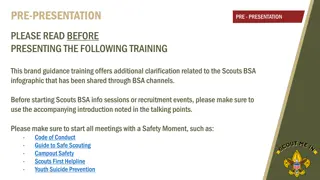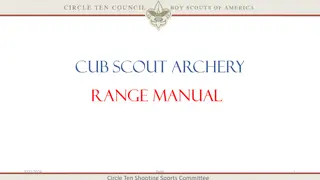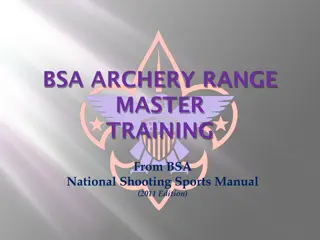BSA Archery Range Safety Briefing
Learn essential archery safety rules and shooting fundamentals. Understand proper bow handling, stance, aiming, and release techniques. Develop skills under supervision for safe archery enjoyment.
Download Presentation

Please find below an Image/Link to download the presentation.
The content on the website is provided AS IS for your information and personal use only. It may not be sold, licensed, or shared on other websites without obtaining consent from the author.If you encounter any issues during the download, it is possible that the publisher has removed the file from their server.
You are allowed to download the files provided on this website for personal or commercial use, subject to the condition that they are used lawfully. All files are the property of their respective owners.
The content on the website is provided AS IS for your information and personal use only. It may not be sold, licensed, or shared on other websites without obtaining consent from the author.
E N D
Presentation Transcript
BSA Archery Range Safety Briefing NO ARROWS in the classroom NO EXCEPTIONS! 1
Orientation Goal To provide beginning archers with the knowledge, skills, and attitude necessary to shoot a archery safely under the direct supervision of a BSA archery rangemaster, a USA Archery Level 1 (or higher) instructor or an NCS certified Shooting Sports Director. 2
Archery Safety Rules ALWAYS keep your bow pointed in a safe direction ALWAYS keep your finger off the bow string until ready to shoot ALWAYS keep your arrow off the string until ready to use 3
The Archery Range The Waiting Line: Archers wait behind this line until directed to advance onto the range. Target Line The Shooting Line: Archers advance to the shooting line when they are directed to. This is usually done by the instructor issuing two whistle blasts. Shooting Line Waiting Line The Target Line: Should be at least 5 ft. in front of the targets. Shooters wait here until given the command to take arrows out of the target. If two individuals are shooting at the same target, this is where one will wait while the other retrieves their arrows. 7
Shooting Fundamentals Determining Eye Dominance Extend arms forward and form opening between the hands With both eyes open, look at a distant object through opening Bring hands to face while looking at object Opening will be aligned with the dominant eye 8
Shooting Fundamentals Determining Eye Dominance Archers should usually draw back the bowstring with their dominant hand, even if it does not match up with their dominant eye. If they are cross-dominant, consider closing their dominant eye when shooting. 9
Archery Shooting Fundamentals 1. STANCE 2. NOCK THE ARROW 3. HOOK AND GRIP 4. RAISE THE BOW 5. DRAW 6. ANCHOR 7. HOLD 8. AIM 9. RELEASE/FOLLOW-THROUGH 10
Archery Shooting Fundamentals STANCE Stand with feet STRADDLING the shooting line. Feet should be about shoulder-width apart. Shooting Line Move the foot closest to the target back about 3 inches. Turn the toes of both feet toward the target about 30 degrees. 11
Archery Shooting Fundamentals Nock the Arrow Grasp the arrow below the nock. Bring the arrow up and over the bow and place it on the arrow rest. Spin the arrow so the index vane (usually a different color) points away from the bow. Push the nock into place on the bowstring directly below the nocking point. (When the arrow is securely placed on the bow string the archer feels and/or hears the arrow snap into place.) 12
Archery Shooting Fundamentals Hook and Grip Curl the bowstring with the fingertips of the index, middle, and ring fingers UNDER the nock of the arrow. Pull the bowstring back enough to apply a small amount of tension. Center the meaty part of the grip hand on the bow grip. Hold the bow grip loosely. 13
Archery Shooting Fundamentals Raise the Bow Turn the head towards the target. Rotate the elbow of the bow arm away from the bowstring. Lift both arms to shoulder height. Extend the bow arm fully, keeping the bow vertical. 14
Archery Shooting Fundamentals Draw Pull the bowstring toward the face. The draw should be seamless and smooth. 15
Archery Shooting Fundamentals Anchor Settle the index finger of the draw hand into the corner of the mouth. Keep the draw hand relaxed and against the face. It is critical that the archer pull the bowstring back to a consistent anchor point every time to maintain accuracy. 16
Archery Shooting Fundamentals Aim Place the point of the arrow on the intended target area. The eye focus is equally on the arrow point and the target. You will adjust your point of aim after you see where you initial shots are placed on the target. 17
Archery Shooting Fundamentals Release/Follow-Through Relax the fingertips to allow the bowstring to push the fingers out of the way. Keep the bow arm up as the arrow leaves the bow. Finish the shot by allowing the draw hand to fall between the ear and the shoulder. 18
Archery Shooting Fundamentals The Fundamentals A Review 1. STANCE 2. NOCK THE ARROW 3. HOOK AND GRIP 4. RAISE THE BOW 5. DRAW 6. ANCHOR 7. HOLD 8. AIM 9. RELEASE/FOLLOW-THROUGH 19
Know the Proper Whistle Codes Two Whistle Blasts: Move to the shooting line One Whistle Blast: Fire the proper number of arrows. Three Whistle Blasts: Move to the target line. Retrieve arrows when directed by the instructor. Five or More Whistle Blasts: Stop shooting. Stay where you are. This is an EMERGENCY. The range officer will tell archers what action to take. 20
Safety Guidelines NEVER dry fire a bow. Always uses arrows that are correct for your draw length. Remember - STRADDLE the shooting line. Always keep your arrows pointed down or towards the target. Always walk on the range. Shoot only at the target that is in front of you. 21
Retrieving Arrows Leave the bow at the shooting line when the command is given to retireve arrows (3 whistle blasts). ALWAYS walk on the range. When retrieving arrows from a target, place the non-dominant hand against the target face with the arrow shaft between your fingers. Grasp the arrow shaft close to the target face with your dominant hand. Pull back while twisting the arrow. If part of the arrow is still in the target, reposition your dominant hand close to the target face and repeat. Once the arrow is out of the target, drop it on the ground in front of the target. Pick up the arrows so they are all facing the same way. Hold the arrows with both hands, palms facing down. One hand next to the fletchings/vanes, the other, behind the arrow heads. Walk back holding the arrows horizontally and replace the arrows in the quiver. 22
BSA Guidelines Lion and Tiger Cubs must shoot with an adult partner. Cub Scouts must wear arm guards and finger tabs or gloves. (Unless the bow string has finger savers.) Scouts, BSA members, Venturers, and Sea Scouts must wear arm guards. 23
Questions? What are your questions before you move to the Waiting Area? 24























